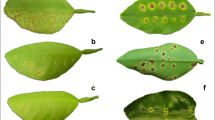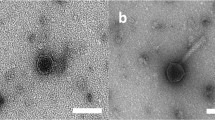Abstract
Bacteriophages were isolated from naturally infected citrus canker lesions from diverse locations in Florida and Argentina and characterized for host range using a world-wide collection of Xanthomonas citri subsp. citri (Xcc) strains. Sixty-seven bacteriophages isolated from citrus canker lesions in Florida (37 bacteriophages) and Argentina (30 bacteriophages) revealed little diversity. All 30 phages isolated from four locations in Argentina had identical host ranges (group ARG), while 37 phages from Florida made up two groups (FLA and FLB). ARG and the 31 FLA phages produced clear plaques and had nearly identical host ranges as phage CP2 of Japan in that they only reacted with typical A strains and none of the atypical A strains (A* and AW) or other Xanthomonas spp. FLB phages had a different host range from the other strains and produced turbid plaques. We used phage typing, fatty acid analysis and riboprinter analysis to classify citrus-associated xanthomonads. Phage typing using 12 phages isolated from Xcc, X. fuscans subsp. aurantifolii (Xfa), X. alfalfae subsp. citrumelonis (Xacm), and other sources proved useful for classifying all major Xcc pathotypes and/or strains (A, A*, Miami (MI), Manatee (MA) and Wellington (AW)), as well as B and C types of Xfa. X. citri subsp. citri strains from a worldwide collection were diverse in phage susceptibility. The majority of Xcc strains, which originated from different regions of the world and which were typical “A” pathotype strains based on pathogenicity characteristics, was sensitive to most phages (including CP2, FLA and ARG), and had nearly identical phage sensitivity profiles. MA strains were quite unique in that they reacted with none of the phages; furthermore, they were different from the putative progenitor MA strain, ATCC 49118, which reacted with a group of phages. Fatty acid analysis revealed considerable variation in Xcc-A, Xfa-B, Xfa-C and Xacm strains. Using riboprinter analysis, we identified a unique riboprinter pattern for strains isolated from an etrog tree (Citrus medica) in Florida that were “A” pathotype strains based on pathogenicity characteristics. Phage typing and fatty acid analysis were useful in corroborating that the etrog strains represent a unique new Xcc strain in Florida.



Similar content being viewed by others
References
Alvarez, A. M., Benedict, A. A., Mizumoto, C. Y., Pollard, L. W., & Civerolo, E. L. (1991). Analysis of Xanthomonas campestris pv. citri and X. c. citrumelo with monoclonal antibodies. Phytopathology, 81, 857–865.
Bui Thi Ngoc, L., Verniere, C., Jouen, E., Ah-You, N., Lefeuvre, P., Chiroleu, F., et al. (2009). From local surveys to global surveillance: three high throughput genotyping methods for the epidemiological monitoring of Xanthomonas citri pv. citri pathotypes. Applied and Environmental Microbiology, 75, 1173–1184.
Bui Thi Ngoc, L., Vernière, C., Gagnevin, L., & Pruvost, O. (2010). Amplified fragment length polymorphism and multilocus sequence analysis-based genotypic relatedness among pathogenic variants of Xanthomonas citri pv. citri and Xanthomonas campestris pv. bilvae. International Journal of Systematic and Evolutionary Microbiology, 60, 515–525.
Civerolo, E. L. (1973). Relationship of Xanthomonas pruni bacteriophages to bacterial spot disease in Prunus. Phytopathology, 63, 1279–1284.
Civerolo, E. L. (1984). Bacterial canker disease of citrus. Journal of the Rio Grande Valley Horticultural Society, 37, 127–146.
Cubero, J., & Graham, J. H. (2002). Genetic relationship among worldwide strains of Xanthomonas causing canker in citrus species and design of new primers for their identification by PCR. Applied and Environmental Microbiology, 68, 1257–1264.
Egel, D. S., Graham, J. H., & Stall, R. E. (1991). Genomic relatedness of Xanthomonas campestris strains causing diseases of citrus. Applied and Environmental Microbiology, 57, 2724–2730.
Gill, J. J., Svircev, A. M., Smith, R., & Castle, A. J. (2003). Bacteriophages of Erwinia amylovora. Applied and Environmental Microbiology, 69, 2133–2138.
Goto, M. (1992). Fundamentals of bacterial plant pathology. San Diego: Academic.
Goto, M., Serizawa, S., & Morita, M. (1970). Studies on citrus canker disease. II. Leaf infiltration technique for detection of Xanthomonas citri (Hasse) Dowson, with special reference to comparison with phage method. Bulletin of the Faculty of Agriculture, Shizuoka University, 20, 1–19.
Goto, M., Takahashi, T., & Messina, M. A. (1980). A comparative study of the strains of Xanthomonas campestris pv. citri isolated from citrus canker in Japan and cancrosis B in Argentina. Nihon Shokubutsu Byori Gakkaiho. Annals of the Phytopathological Society of Japan, 46, 329–338.
Gottwald, T. R., Graham, J. H., & Schubert, T. S. (2002). Citrus canker: the pathogen and its impact. Plant Health Progress. doi:10.1094/PHP-2002-0812-01-RV.
Koizumi, M., & Timmer, L. W. (1985). Citrus canker: The world situation. In Anonymous (Ed.), Citrus canker: An international perspective (pp. 2–7). Lake Alfred: Citrus Research & Education Center, University of Florida.
Norman, D. J., Chase, A. R., Hodge, N. C., & Stall, R. E. (1997). Differentiation of three species of Xanthomonas and Stenotrophomonas maltophilia using cellular fatty acid analyses. European Journal of Plant Pathology, 103, 687–693.
Obradovic, A., Mavridis, A., Rudolph, K., Janse, J. D., Arsenijevic, M., Jones, J. B., et al. (2004). Characterization and PCR-based typing of Xanthomonas campestris pv. vesicatoria from peppers and tomatoes in Serbia. European Journal of Plant Pathology, 11, 285–292.
Pruvost, O., Hartung, J. S., Civerolo, E. L., Dubois, C., & Perrier, X. (1992). Plasmid DNA fingerprints distinguish pathotypes of Xanthomonas campestris pv. citri, the causal agent of citrus bacterial canker disease. Phytopathology, 82, 485–490.
Rizvi, S., & Mora, P. T. (1963). Bacteriophage plaque-count assay and confluent lysis on plates without bottom agar layer. Nature, 200, 1324–1325.
Roumagnac, P., Gagnevin, L., Gardan, L., Sutra, L., Manceau, C., Dickstein, E. R., et al. (2004). Polyphasic characterization of xanthomonads isolated from onion, garlic and Welsh onion (Allium spp.) and their relatedness to different Xanthomonas species. International Journal of Systematic Bacteriology, 54, 15–24.
Rybak, M., Minsavage, G. V., Stall, R. E., & Jones, J. B. (2009). Identification of Xanthomonas citri ssp. citri host specificity genes in a heterologous expression host. Molec. Plant Pathology, 10, 249–262.
Sambrook, J., Fritsch, E. F., & Maniatis, T. (1989). Molecular cloning: A laboratory manual. Cold Spring Harbor: Cold Spring Harbor Laboratory.
Sasser, M. (2001). Identification of bacteria by gas chromatography of cellular fatty acids. Technical note #101. MIDI, Newark, DE.
Schubert, T. S., Rizvi, S. A., Sun, X., Gottwald, T. R., Graham, J. H., & Dixon, W. N. (2001). Meeting the challenge of eradicating citrus canker in Florida—Again. Plant Disease, 85, 340–356.
Stall, R. E., & Civerolo, E. L. (1991). Research relating to the recent outbreak of citrus canker in Florida. Annual Review of Phytopathology, 29, 399–420.
Sun, X., Stall, R. E., Jones, J. B., Cubero, J., Gottwald, T. R., Graham, J. H., et al. (2004). Detection and characterization of a new strain of citrus canker bacteria from Key/Mexican lime and alemow in south Florida. Plant Disease, 88, 1179–1188.
Verniere, C., Hartung, O. P., Pruvost, E. L., Civerolo, A. M., Alvarez, P. M., & Luisetti, J. (1998). Characterization of phenotypically distinct strains of Xanthomonas axonopodis pv. citri from Southwest Asia. European Journal of Plant Pathology, 104, 477–487.
Vidaver, A. K., & Schuster, M. L. (1960). Characterization of Xanthomonas phaseoli bacteriophages. Journal of Virology, 4, 300–308.
Wang, C., Siu, L. K., Chen, M. K., Yu, Y., Lin, F. M., Ho, M., et al. (2001). Use of automated riboprinter and pulsed-field gel electrophoresis for epidemiological studies of invasive Haemophilus influenzae in Taiwan. Journal of Medical Microbiology, 50, 277–283.
Wu, W. C. (1972). Phage-induced alterations of cell disposition, phage adsorption and sensitivity, and virulence in Xanthomonas citri. Annals of the Phytopathological Society of Japan, 38, 333–341.
Wu, W. C., Lee, S. T., Kuo, H. F., & Wang, L. Y. (1993). Use of phages for indentifying the citrus canker bacterium Xanthomonas campestris pv. citri in Taiwan. Plant Pathology, 42, 389–395.
Author information
Authors and Affiliations
Corresponding author
Electronic supplementary material
Below is the link to the electronic supplementary material.
Supplementary Figure 1
Dendrogram showing relationships of 106 Xanthomonas strains isolated from citrus and other select xanthomonads based on riboprinter profiles. The dendogram was constructed by UPGMA based on similarity values calculated using the Pearson correlation using Bionumerics software package version 3.0. (DOC 495 kb)
Rights and permissions
About this article
Cite this article
Balogh, B., Dickstein, E.R., Jones, J.B. et al. Narrow host range phages associated with citrus canker lesions in Florida and Argentina. Eur J Plant Pathol 135, 253–264 (2013). https://doi.org/10.1007/s10658-012-0082-6
Accepted:
Published:
Issue Date:
DOI: https://doi.org/10.1007/s10658-012-0082-6




